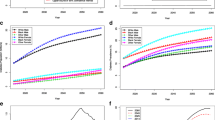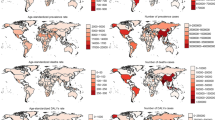Abstract
This study develops forecasts of the number of people with diagnosed diabetes and diagnosed diabetes prevalence in the United States through the year 2050. A Markov modeling framework is used to generate forecasts by age, race and ethnicity, and sex. The model forecasts the number of individuals in each of three states (diagnosed with diabetes, not diagnosed with diabetes, and death) in each year using inputs of estimated diagnosed diabetes prevalence and incidence; the relative risk of mortality from diabetes compared with no diabetes; and U.S. Census Bureau estimates of current population, live births, net migration, and the mortality rate of the general population. The projected number of people with diagnosed diabetes rises from 12.0 million in 2000 to 39.0 million in 2050, implying an increase in diagnosed diabetes prevalence from 4.4% in 2000 to 9.7% in 2050.
Similar content being viewed by others
References
Centers for Disease Control and Prevention, Diabetes Surveillance (1999) Ch. 1, The Public Health Burden of Diabetes Mellitus in the United States. (Available at http://www.cdc.gov/diabetes/statistics/ survl99/chap1/contents.htm, accessed April 2001.)
American Diabetes Association, Economic consequences of diabetes mellitus in the U.S. in 1997, Diabetes Care 21(2) (1998) 296-309.
R.B. Helms, Implications of population growth on prevalence of diabetes: A look at the future, Diabetes Care 15(S1) (1992) 6-9.
H. King, R.E. Aubert and W.H. Herman, Global burden of diabetes, 1995-2025: Prevalence, numerical estimates, and projections, Diabetes Care 21(9) (1998) 1414-1431.
J.P. Boyle, A.A. Honeycutt, K.M. Venkat-Narayan, T.J. Hoerger, L.S. Geiss, H. Chen and T.J. Thompson, Projection of diabetes burden and cost through 2050: Impact of changing demography and disease prevalence in the U.S., Diabetes Care 24(11) (2001) 1936-1940.
D. Ruwaard, R.T. Hoogenveen, H. Verkleij, D. Kromhout, A.F. Casparie and E.A. van der Veen, Forecasting the number of diabetic patients in The Netherlands in 2005, American Journal of Public Health 83(7) (1993) 989-995.
Centers for Disease Control and Prevention, Diabetes Surveillance, Prevalence and Incidence (1999) Ch. 2. (Available at http://www.cdc. gov/diabetes/statistics/surv1999/chap2/contents.htm, accessed February 2002.)
U.S. Census Bureau, Annual Projections of the Resident Population by Age, Sex, Race and Hispanic Origin: Lowest, Middle, Highest, and Zero International Migration Series, 1999 to 2100, Population Projections Program, Population Division, U.S. Census Bureau, Washington, DC (2000).
S.L. Botman, T.F. Moore, C.L. Moriarity and V.L. Parsons, Design and estimation for the National Health Interview Survey, 1995-2004, National Center for Health Statistics, Vital and Health Statistics 2(130) (2000).
P.J. O'Conner, W.A. Rush, N.P. Pronk and L.M. Cherney, Identifying diabetes mellitus or heart disease among health maintenance organization members: Sensitivity, specificity, predictive value, and cost of survey and database methods, American Journal of Management Care 4 (1998) 335-342.
W.S. Edwards, D.M. Winn and V. Kurlantzick, Evaluation of National Health Interview Survey diagnostic reporting, Vital and Health Statistics 2(120).
C.F. Turner, T.K. Smith and L.K. Fitterman, The quality of health care data obtained in a new survey of elderly Americans: A validation study of the proposed Medicare beneficiary health status registry, Journal of Gerontology: Social Sciences 52B (1997) S49-S58.
S.J. Kenney, R.E. Aubert and L.S. Geiss, Prevalence and incidence of non-insulin-dependent diabetes, in: Diabetes in America, 2nd Ed., ed. M.I. Harris, NIH pub. No. 95-1468 (1995).
G. Schwarz, Estimating the dimension of a model, Annals of Statistics 6 (1978) 461-464.
D.W. Hosmer and S. Lemeshow, Goodness-of-fit tests for the multiple logistic regression model, Communications in Statistics - Theory and Methods 9 (1980) 1043-1069.
F.W. Hollmann, T.J. Mulder and J.E. Kallan, U.S. Census Bureau, Methodology and Assumptions for the Population Projections of the United States, 1999 to 2100, Population Division Working Paper No. 38, U.S. Census Bureau, Washington, DC. (Available at http:// www.census.gov/population/www/documentation/twps0038.pdf, January 13, 2000.)
U.S. Census Bureau, Component Assumptions of the Resident Population by Age, Sex, Race, and Hispanic Origin: Lowest, Middle, and Highest Series, 1999 to 2100, Population Projections Program, Population Division, U.S. Census Bureau, Washington, DC (2000).
E.F. Tierney, L.S. Geiss, M.M. Engelgau, T.J. Thompson, D. Schaubert, L.A. Shireley, P.J. Vukelic and S.L. McDonough, Population-based estimates of mortality associated with diabetes: Use of a death certificate check box in North Dakota, American Journal of Public Health 91(1) (2001) 84-92.
J.S. Dorman, R.E. Laporte, L.H. Kuller, K.J. Cruickshanks, T.J. Orchard, D.K. Wagener, D.J. Becker, D.E. Cavender and A.L. Drash, The Pittsburgh insulin-dependent diabetes mellitus (IDDM) morbidity and mortality study: Mortality results, Diabetes 33(3) (1984) 271-276.
S.E. Moss, R. Klein and B.E. Klein, Cause-specific mortality in a population-based study of diabetes, American Journal of Public Health 81(9) (1991) 1158-1162.
R. Lipton, G. Good, T. Mikhailov, S. Freels and E. Donoghue, Ethnic differences in mortality from insulin-dependent diabetes mellitus among people less than 25 years of age, Pediatrics 103(5) (1999) 952-956.
K. Gu, C.C. Cowe and M.I. Harris, Mortality in adults with and without diabetes in a national cohort of the U.S. population, 1971-1993, Diabetes Care 21(7) (1998) 1138-1145.
Diabetes Prevention Program Research Group, Reduction in the incidence of type 2 diabetes with lifestyle intervention or metformin, New England Journal of Medicine 346(6) (2002) 393-403.
Author information
Authors and Affiliations
Rights and permissions
About this article
Cite this article
Honeycutt, A.A., Boyle, J.P., Broglio, K.R. et al. A Dynamic Markov Model for Forecasting Diabetes Prevalence in the United States through 2050. Health Care Management Science 6, 155–164 (2003). https://doi.org/10.1023/A:1024467522972
Issue Date:
DOI: https://doi.org/10.1023/A:1024467522972




